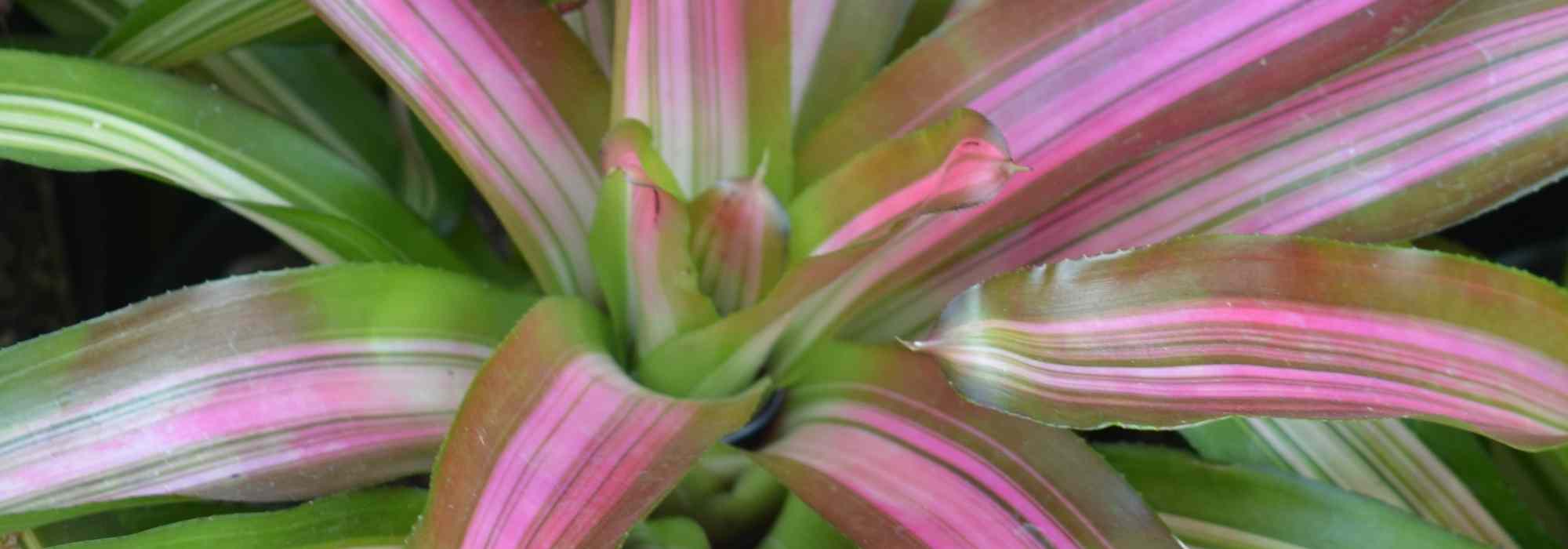
Cryptanthus - Earth star: growing and care
Contents
Cryptanthus in a few words
- Cryptanthus is a tropical plant with colourful and graphic foliage, perfect for indoor settings.
- It prefers a light, well-draining substrate with moderate watering and good humidity.
- Propagation is easily done through offsets after flowering.
- It adapts to various décor styles, particularly in terrariums or stylish pots.
- Low-maintenance, it adds an exotic and elegant touch to any interior.
The word from our expert
The Cryptanthus or Earth Star, often nicknamed the “starfish plant” or, more rarely, “earth star,” is a tropical plant belonging to the Bromeliaceae family. Native to the humid forests of Brazil, this houseplant stands out for its flattened rosette habit and spectacular foliage. Its rigid, dentate leaves display vibrant hues ranging from deep green to bright pink, with shades of red and zebra-like patterns. Suited for indoor cultivation, the Cryptanthus captivates with its ability to elegantly brighten living spaces, even in low-light environments.
Low-maintenance, the Cryptanthus thrives in a light, well-drained substrate and requires moderate watering to avoid excess moisture, to which it is sensitive. This tropical plant flourishes in temperatures between 18 and 27°C, with high ambient humidity, making it an ideal candidate for terrariums. A bright location without direct sunlight allows it to reveal the full richness of its colours.
Propagation of the Cryptanthus is mainly achieved through its offsets, which appear at the base of the plant after flowering. Once the young shoots are sufficiently developed, they can be removed and replanted to give rise to new young plants. This natural reproduction makes the Cryptanthus a sustainable and easy-to-share plant with friends.
In terms of decoration, the Cryptanthus fits seamlessly into various interior styles. In a sleek ceramic pot, it enhances modern and minimalist settings, while a wicker planter or open terrarium highlights its exotic appeal in bohemian or tropical décors.
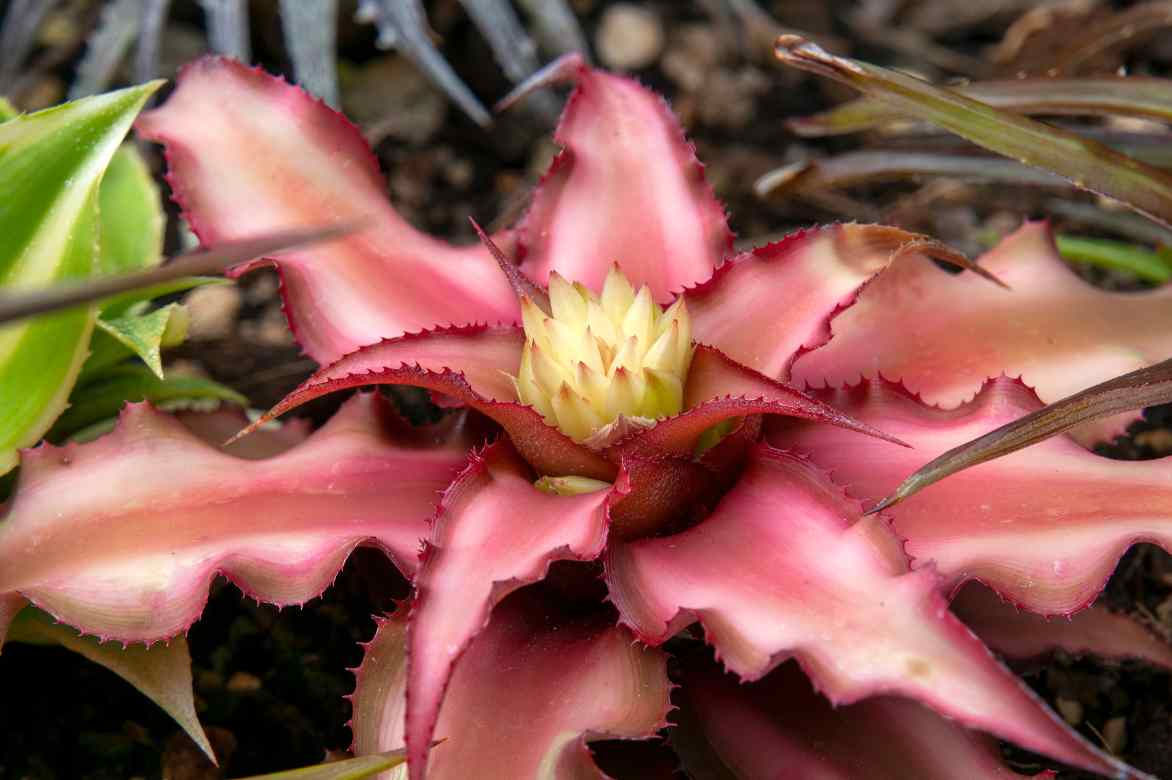
Cryptanthus bivittatus in flower
Botany and description
Botanical data
- Latin name Cryptanthus bivittatus
- Family Bromeliaceae
- Common name Cryptanthus, Earth Star plant
- Flowering June to August
- Height 15 cm
- Exposure bright, no direct sunlight
- Soil type humus-bearing and very well-draining
- Hardiness 15°C
The Cryptanthus belongs to the large Bromeliaceae family, a family that includes a wide variety of exotic plants, sometimes epiphytic, grown indoors (Bromellia, Guzmania, Tillandsia…) and a more well-known plant: the pineapple (Ananas comosus). Its genus name comes from the Greek kryptos, meaning “hidden,” and anthos, meaning “flower,” a poetic reference to its small, discreet flowers nestled in the heart of its foliage. In French, it is called Cryptanthus, but it is also sometimes nicknamed “Earth Star plant” or “Star of the Earth,” names that perfectly evoke the star-shaped form of its leaves, which seem to radiate close to the ground.
In its natural habitat, the Cryptanthus thrives in the humid tropical forests of Brazil. Unlike many of its bromeliad cousins that live attached to trees (epiphytic plants), it prefers to spread across the forest floor, taking advantage of the ambient humidity and filtered light under the canopy. It is precisely this ability to adapt to indirect light conditions and its tolerance for drier air that make it a very popular houseplant. Its spectacular foliage, often striped or tinged with pink, red, or green, adds a graphic and colourful touch to interiors, all while requiring minimal maintenance.
Among the most common Cryptanthus species in cultivation, three stand out particularly for their beauty and diversity: Cryptanthus bivittatus, Cryptanthus acaulis, and Cryptanthus zonatus.
The Cryptanthus bivittatus is the most popular species. It is prized for its slender foliage with vibrant colours, often striped with green, pink, or red. Among its most well-known cultivars are:
- ‘Pink Starlite’ with its stunning bright pink leaves edged with green,
- ‘Ruby’, which displays deep red tones,
- ‘Earth Star’, a classic with star-shaped foliage in shades of pink and green.
The Cryptanthus acaulis, on the other hand, is distinguished by its broader, slightly undulate leaves. It is often chosen for its subtle silvery-green hues. Notable varieties include:
- ‘Green Star’, with intense green foliage,
- ‘Silver Star’, with silvery reflections that catch the light beautifully.
As for Cryptanthus zonatus, it charms with its marbled and striped patterns, giving its foliage an almost animal-like effect. Cultivars such as:
- ‘Zebra’, with its white and green stripes reminiscent of a zebra’s coat,
- ‘Cascade’, which combines grey and green tones with a more relaxed habit, are particularly appreciated for their originality.
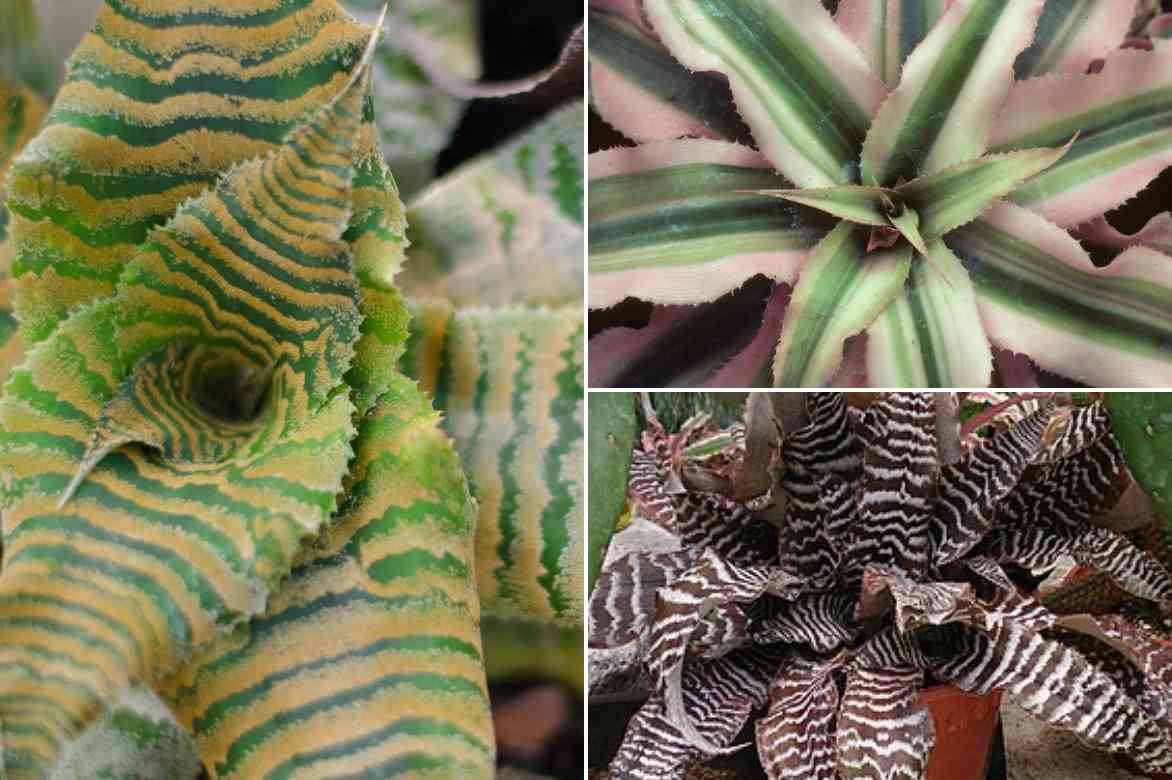
Colours and stripes are among the main attractions of Cryptanthus (photo bottom right Mokkie-Wikimedia Commons)
The Cryptanthus is a compact, spreading plant that naturally forms a dense, flattened rosette (no more than 15 cm tall). Its star-shaped leaves spread close to the ground. Some species, like Cryptanthus bivittatus, have narrower, upright leaves, while others, like Cryptanthus zonatus, develop broader, slightly undulate leaves.
Its root system is quite small and shallow. The roots mainly serve to anchor the plant in the soil rather than to absorb water and nutrients, as the Cryptanthus draws most of its moisture from the surrounding air and the dew deposited on its leaves. This is why it prefers well-drained, light substrates and enjoys regular misting.
The foliage is undoubtedly the Cryptanthus’s greatest asset. Its stiff, leathery leaves are often edged with fine teeth or small, discreet thorns. They come in spectacular colour palettes: deep green, bright pink, intense red, bronze, silver, sometimes even marbled or striped with white. Varieties like ‘Pink Starlite’ offer vivid pink tones, while ‘Zebra’ charms with its contrasting stripes. This decorative foliage remains attractive all year round.
A changing foliage: Cryptanthus leaves change colour depending on the light. Indeed, some Cryptanthus varieties see their colours become more intense when exposed to more indirect light. Pink or red tones thus become more vivid.
The flowering of the Cryptanthus is discreet and often overlooked. Small tubular white or slightly bluish flowers appear at the heart of the rosette. This flowering is not spectacular, but it marks an important stage in the plant’s life cycle. Indeed, like many bromeliads, the Cryptanthus is semelparous, meaning it dies after flowering. However, this end is not abrupt: the plant takes several months, even a year, before completely withering. During this time, it produces offsets, called basal shoots or suckers, which will take over. These young plants can be separated and replanted to prolong the presence of this “Earth Star” in the home.
After flowering, the Cryptanthus may produce small dry fruits containing seeds, although this fruiting is discreet and rare in indoor cultivation. These seeds, nestled in the heart of the rosette, are rarely used for propagation, as their germination is slow and unpredictable.

Cryptanthus zonatus ‘Elaine’
Pot and substrate
The Cryptanthus is a plant that thrives in pots as well as terrariums. To plant it successfully and see it flourish, here are all the tips you need to follow!
Choosing the Pot
The Cryptanthus has a relatively undeveloped root system, so it doesn’t need a large pot. A container with a diameter of 10 to 15 cm is more than enough, especially for young plants or offsets. Opt for a wide and shallow pot to accommodate its rosette growth. Ensure the pot has drainage holes to prevent water stagnation, which could lead to root rot.
In a terrarium, it will thrive in open or semi-closed models to maintain good humidity without excess.
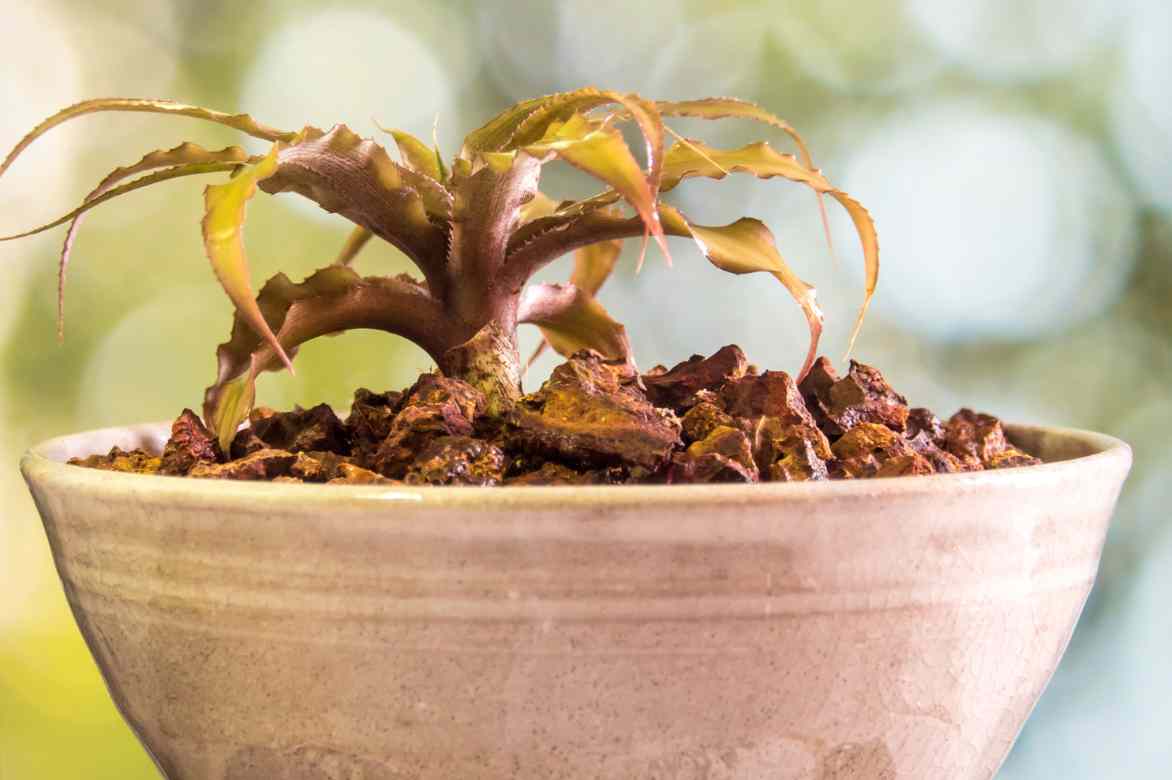
A small pot is sufficient for the Cryptanthus
Ideal Substrate
The Cryptanthus prefers light, well-draining, and slightly acidic substrates. You can prepare a homemade mix with:
- 1/2 tropical plant compost or houseplant compost,
- 1/4 coarse sand or perlite for drainage,
- 1/4 blonde turf or coconut fibre for acidity and moisture retention.
For better aeration, you can add a bit of sphagnum moss or small pieces of pine bark.
☀️Lighting
The Cryptanthus prefers bright, indirect light. Near an east or west-facing window is ideal. It tolerates low-light rooms fairly well. In a terrarium, place it near a natural light source or use a horticultural lamp if light is insufficient.
Temperature
This tropical plant loves warmth! The ideal temperature ranges between 18°C and 27°C. It cannot tolerate cold drafts or temperatures below 15°C. In winter, keep it away from poorly insulated windows and cold sources.
Ambient humidity
The Cryptanthus thrives in humid environments, especially indoors where the air is often dry. The ideal humidity level is around 60 to 80%. To maintain this humidity:
- Mist its leaves lightly with non-calcareous water,
- Place the pot on a bed of damp clay pebbles,
- In a terrarium, humidity is naturally higher due to the closed environment, so frequent watering isn’t necessary.
Planting steps
- Choose a pot with good drainage, or a terrarium.
- Place a layer of clay pebbles or small stones at the bottom of the pot to prevent excess water.
- Prepare a well-draining substrate and fill the pot, leaving a small hollow in the centre.
- Gently remove your Cryptanthus from its pot and loosen the roots if they are too tight.
- Place the plant in the centre of the pot and cover the roots without compacting the substrate too much.
- Water lightly to moisten the soil without soaking it.
- Place it in a bright spot, but away from direct sunlight.
In a terrarium, you can add decorative elements like moss, pebbles, or small pieces of wood to create a lovely natural display.
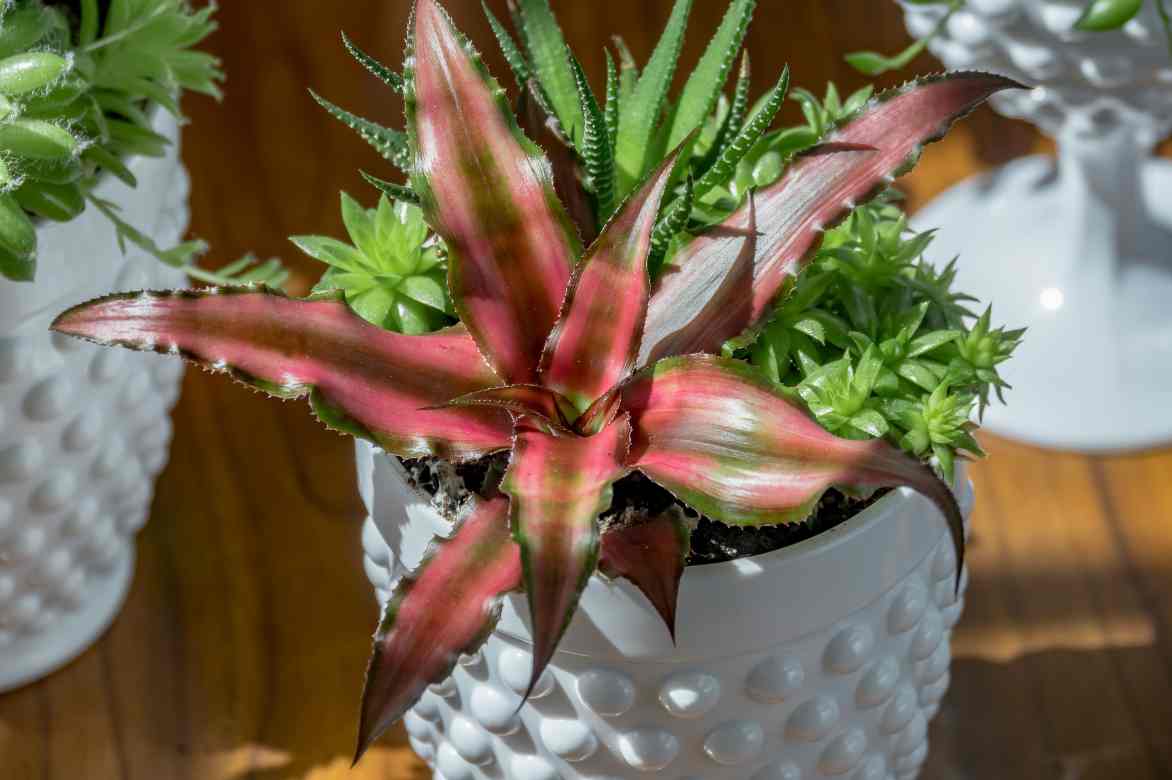
Cryptanthus bipinnatus ‘Ruby Red’
Culture and Care of Cryptanthus
The cultivation and care of Cryptanthus are relatively simple, making it an ideal houseplant, even for beginners. Here are all the tips to take good care of it.
Watering
Cryptanthus prefers a slightly moist substrate but never waterlogged. Its shallow root system is sensitive to excess water.
- During the growth period (spring and summer), it is advisable to water moderately, allowing the substrate to dry slightly between waterings.
- In winter, when growth slows, watering should be spaced out. Watering every 2 to 3 weeks may suffice, depending on the ambient temperature.
- Preferably use non-calcareous water (rainwater or filtered water) at room temperature.
Native to tropical forests, Cryptanthus appreciates high ambient humidity.
- Regular misting of its leaves with soft water is beneficial, especially in winter when indoor air becomes dry due to heating.
- You can also place the pot on a bed of moist clay pebbles to maintain good humidity.
- However, avoid soaking the centre of the rosette to prevent fungal diseases.
Fertilisation
Cryptanthus is not very demanding, but a little boost can enhance its foliage.
- During the growth period (spring/summer), a monthly application of liquid fertiliser for houseplants or tropical plants, diluted to half the recommended dose, is sufficient.
- In autumn and winter, fertilisation is unnecessary.
✂️ Pruning
Cryptanthus does not require regular pruning. Simply remove damaged or dried leaves at the base to maintain a neat appearance. After flowering, the mother plant will gradually decline. It is then recommended to gently detach the offsets (suckers) that appear around it to replant them.
Repotting
Cryptanthus grows slowly, and its root system is not extensive.
- Repotting every 2 to 3 years is sufficient, or when it seems cramped in its pot.
- Repotting is ideal in spring, in a slightly larger pot, with fresh, well-draining substrate.
- For offsets, wait until they reach at least one-third the size of the mother plant before separating and replanting them (see propagation section).
Precautions to Take
- Avoid overwatering, as the shallow roots are prone to rot.
- Protect from cold drafts, which can damage the leaves.
- Clean the leaves occasionally with a soft cloth to remove dust and promote the plant’s respiration.
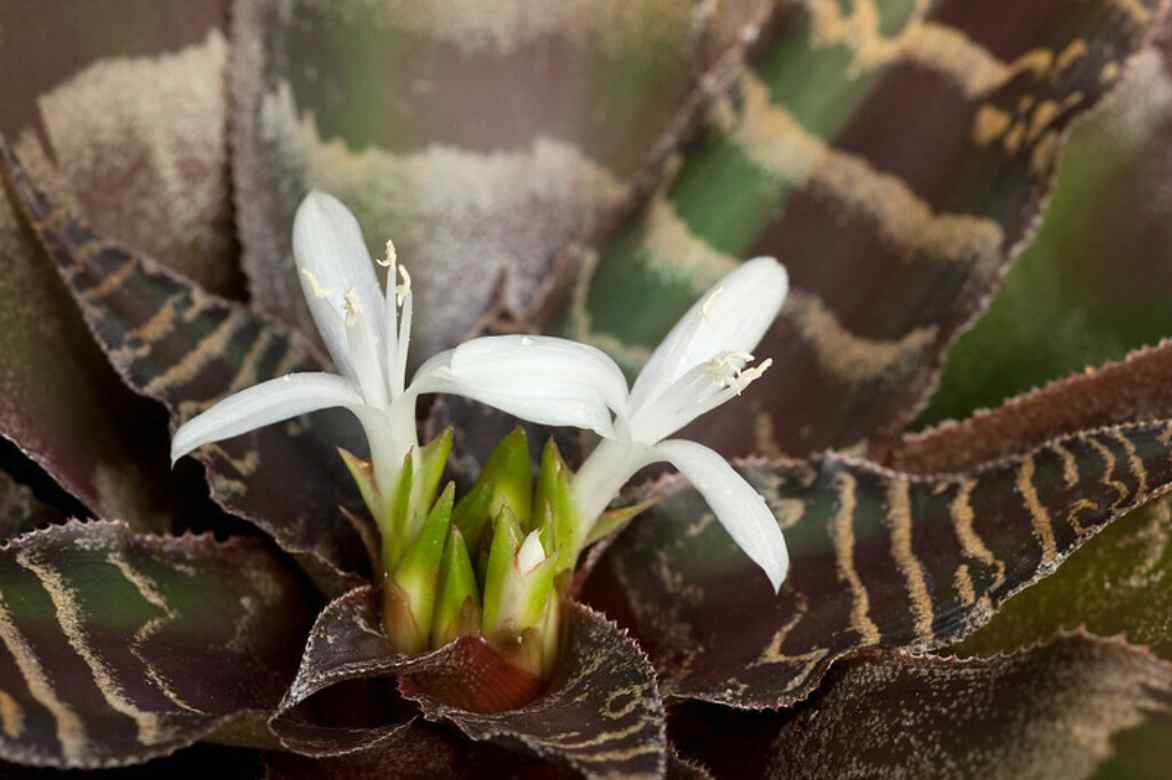
Flowering of Cryptanthus fosterianus (photo Cecilia Alexander)
Potential Parasites and Diseases
The Cryptanthus is generally a robust plant, but like all houseplants, it can be vulnerable to certain parasitic and diseases, especially if growing conditions are not optimal. Here are the main problems it may face and how to prevent or treat them.
Common Parasites
- Mealybugs
- Symptoms: small white, cottony clusters on the leaves and at the base of the rosette.
- Causes: overly dry atmosphere or lack of ventilation.
- Treatment: clean the leaves with a cloth soaked in a mixture of water and black soap or 70% alcohol.
- Aphids
- Symptoms: small green, black, or yellow insects clustered on young leaves or around the rosette. Sticky and deformed leaves.
- Causes: excess humidity and lack of ventilation.
- Treatment: spray with a soapy water mixture or black soap. Aphids can also be removed with a gentle jet of water.
- Spider Mites
- Symptoms: pale leaves with small yellow or brown spots, sometimes accompanied by fine webs.
- Causes: overly dry air and excessive heat.
- Treatment: increase humidity by misting regularly. Clean the leaves and, if necessary, apply a natural miticide.
- Thrips
- Symptoms: small silver streaks on the leaves, discoloured appearance, deformed leaves.
- Causes: dry air and high temperatures.
- Treatment: mist regularly, isolate the plant, and use an organic insecticide if needed.
Frequent Diseases
- Root Rot
- Symptoms: yellowing leaves that become soft, and an unpleasant smell from the substrate.
- Causes: overwatering, overly compact or poorly draining substrate.
- Prevention and Treatment:
- use a well-draining substrate.
- water moderately and remove stagnant water from the saucer.
- in case of rot, remove the plant, trim damaged roots, and repot in a healthy substrate.
- Collar Rot
- Symptoms: base of the plant turning black and soft.
- Causes: stagnant water in the heart of the rosette or overly wet substrate.
- Prevention and Treatment:
- avoid pouring water directly into the heart of the plant.
- ensure good drainage.
- in case of infection, it is often difficult to save the plant. Take healthy offsets to replant.
- Fungal Spots
- Symptoms: appearance of brown or black spots on the leaves.
- Causes: excess humidity, lack of ventilation.
- Prevention and Treatment:
- space out watering.
- remove affected leaves.
Prevention Tips
- Maintain good humidity, but avoid excess water.
- Use a light and well-draining substrate.
- Avoid cold drafts and sudden temperature changes.
- Clean the leaves regularly to prevent dust buildup.
- Monitor the plant closely and act quickly at the first sign of parasites or diseases.
Learn more in our article Cryptanthus: Diseases, Parasites, and Common Problems of This Houseplant.
Propagation of Cryptanthus
Propagating Cryptanthus is quite straightforward and is mainly done through its offsets, also known as suckers. This method of propagation is natural, as the mother plant spontaneously produces young shoots around it before withering after flowering. This technique ensures the preservation of the characteristics of the varieties, unlike sowing, which can produce plants with variable patterns and colours. Here’s a step-by-step guide to successfully propagate your Cryptanthus.
- Observe the mother plant: after flowering, the Cryptanthus begins to produce small offsets at the base of the rosette. These shoots resemble tiny miniature stars attached to the main plant.
- Wait for the right time: it is important to let the offsets grow before removing them. They should measure at least 5 to 8 cm or reach one-third the size of the mother plant. This ensures they are robust enough to survive on their own.
- Prepare the materials:
- clean pruning shears or a sharp, disinfected knife.
- small pots with suitable substrate (a mix of light potting soil, sand, and turf).
- non-calcareous water.
- Detach the offsets
- carefully remove the mother plant from its pot to better access the offsets.
- cleanly cut the offset at its base, where it attaches to the mother plant. Be careful not to damage any young roots if they are already present.
- Plant the offsets
- fill a small pot with light, well-draining substrate (potting soil + perlite).
- plant the offset by slightly burying its base without covering the rosette.
- lightly firm the soil around to keep the plant in place.
- Initial care after planting
- water lightly to moisten the substrate without soaking it.
- place the pot in a warm, bright spot, but avoid direct sunlight. A temperature around 22 to 26°C will encourage rooting.
- maintain good ambient humidity with regular misting or by placing the pot under a cloche or in a terrarium.
- Monitor the recovery
- the first roots develop within four to five weeks.
- once growth accelerates and new leaves appear, you can resume standard care.
Please note: Cryptanthus can also be propagated by sowing, but this method is slower and more delicate. It is rarely used by amateurs, as the seeds are difficult to obtain and their germination is slow. Moreover, sowing will not necessarily produce a plant similar to the mother plant. Sow the seeds on a moist, light substrate, maintain a constant temperature (25°C), and ensure high humidity. Germination can take several weeks to several months.
How to showcase a star of the earth?
Types of Interiors Suitable for Cryptanthus
Modern and Minimalist Interior
Its geometric shapes and vibrant colours contrast beautifully with clean lines and neutral tones. Varieties like Cryptanthus bivittatus ‘Pink Starlite’, with its bright pink leaves, add a bold splash of colour without cluttering the space.
Bohemian or Urban Jungle Style
Cryptanthus blends perfectly into a dense plant-filled décor, mingling with tropical plants, wicker baskets, and natural materials. Species with marbled patterns, like Cryptanthus zonatus ‘Zebra’, add interesting textures among more classic foliage.
Industrial Décor
In an interior with raw materials (concrete, metal, dark wood), the deep colours of Cryptanthus bivittatus ‘Ruby’ or Cryptanthus acaulis create an elegant contrast. Placed in a raw concrete or black metal pot, it enhances the contemporary spirit of this style.
Scandinavian Ambience
In interiors with light tones and soft materials, Cryptanthus with gentle hues like ‘Earth Star’ or ‘Green Star’ add a subtle touch of greenery. A white or pastel ceramic pot, or even light wood, highlights the simplicity of the plant.
Types of Pots and Terrariums to Enhance Cryptanthus
Ceramic or Raw Concrete Pots
Ideal for brightly coloured varieties like ‘Pink Starlite’ or ‘Ruby’, which stand out against understated materials. Geometric or clean-lined pots accentuate its star-shaped habit.
Open or Semi-Closed Terrariums
Cryptanthus loves humidity, making it a perfect candidate for terrariums. Paired with moss, pebbles, and a few pieces of driftwood, it creates a mini tropical garden. Species like Cryptanthus zonatus work well in these compositions.
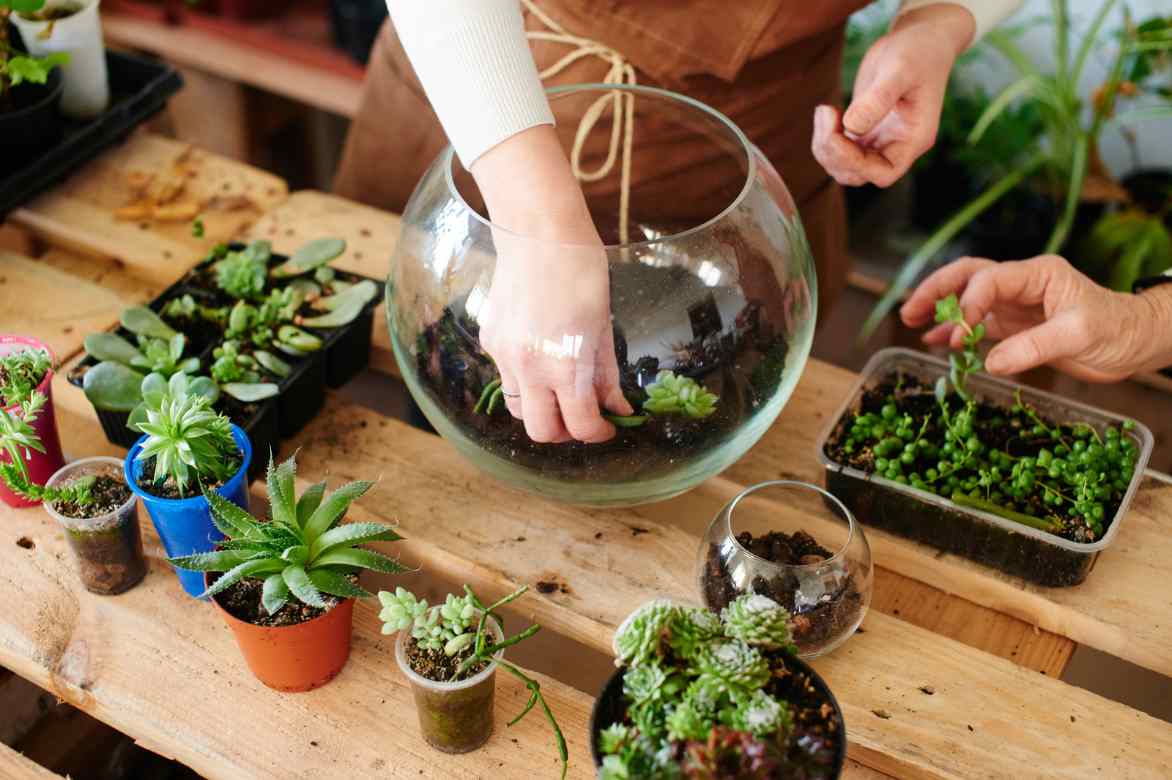
Hanging Pots or Wide Bowls
Placed in a shallow bowl or hanging pot, its rosette habit is beautifully showcased. Glass or glazed terracotta pots emphasise its graphic appeal.
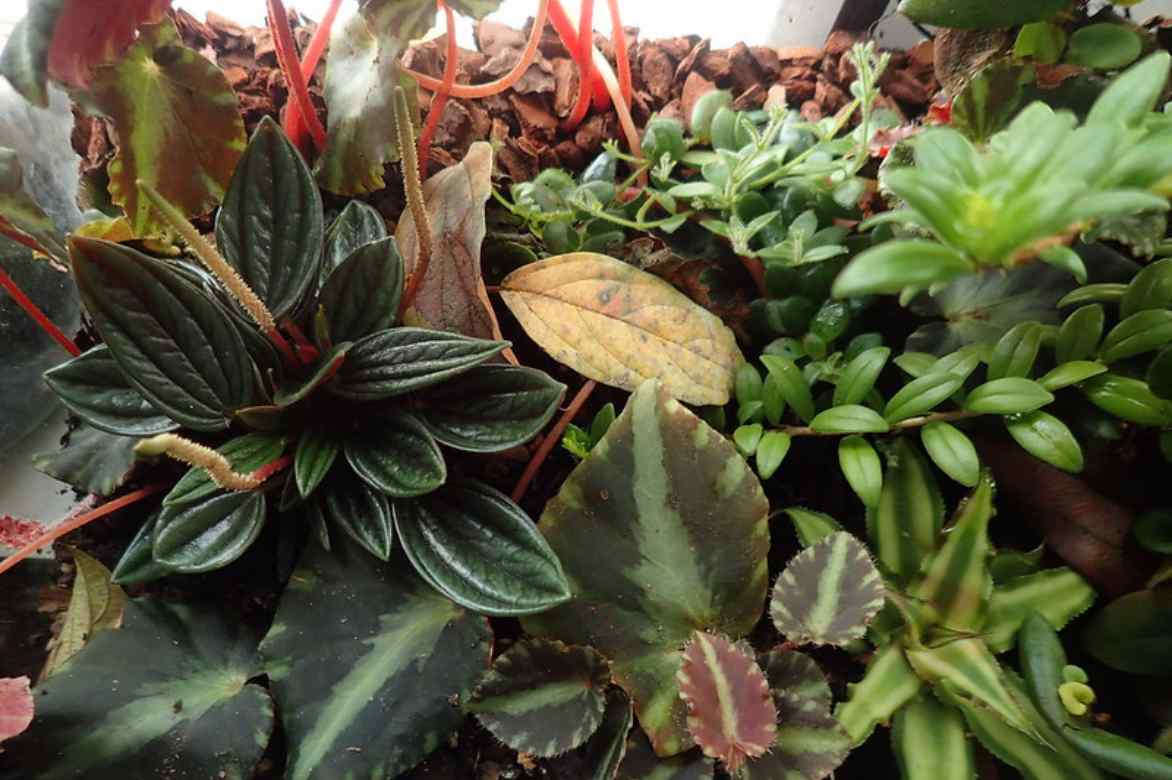
Cryptanthus acaulis at the bottom right, suspended with a Peperomia rosso, a Begonia cleopatrae, and Aeschynanthus buxifolius (Photo Peganum-Flickr)
Natural Material Planters
For a bohemian décor, a rattan, wicker, or jute planter adds a warm touch that contrasts with its structured foliage.
✨ Décor Tip
Combine several Cryptanthus of different colours and varieties in the same container or in several coordinated small pots to create a highly decorative graphic effect. Playing with heights, textures, and pot materials enhances their natural beauty.
Also worth reading
→ Discover our wide range of houseplants.
- Subscribe!
- Contents
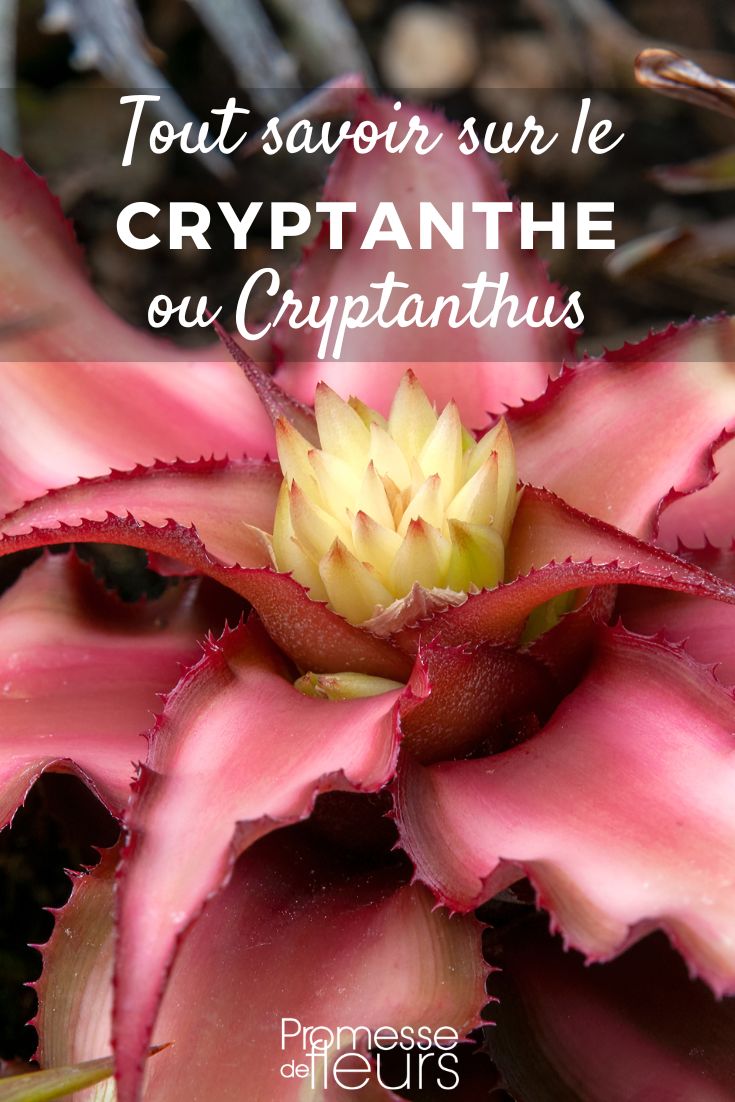































Comments